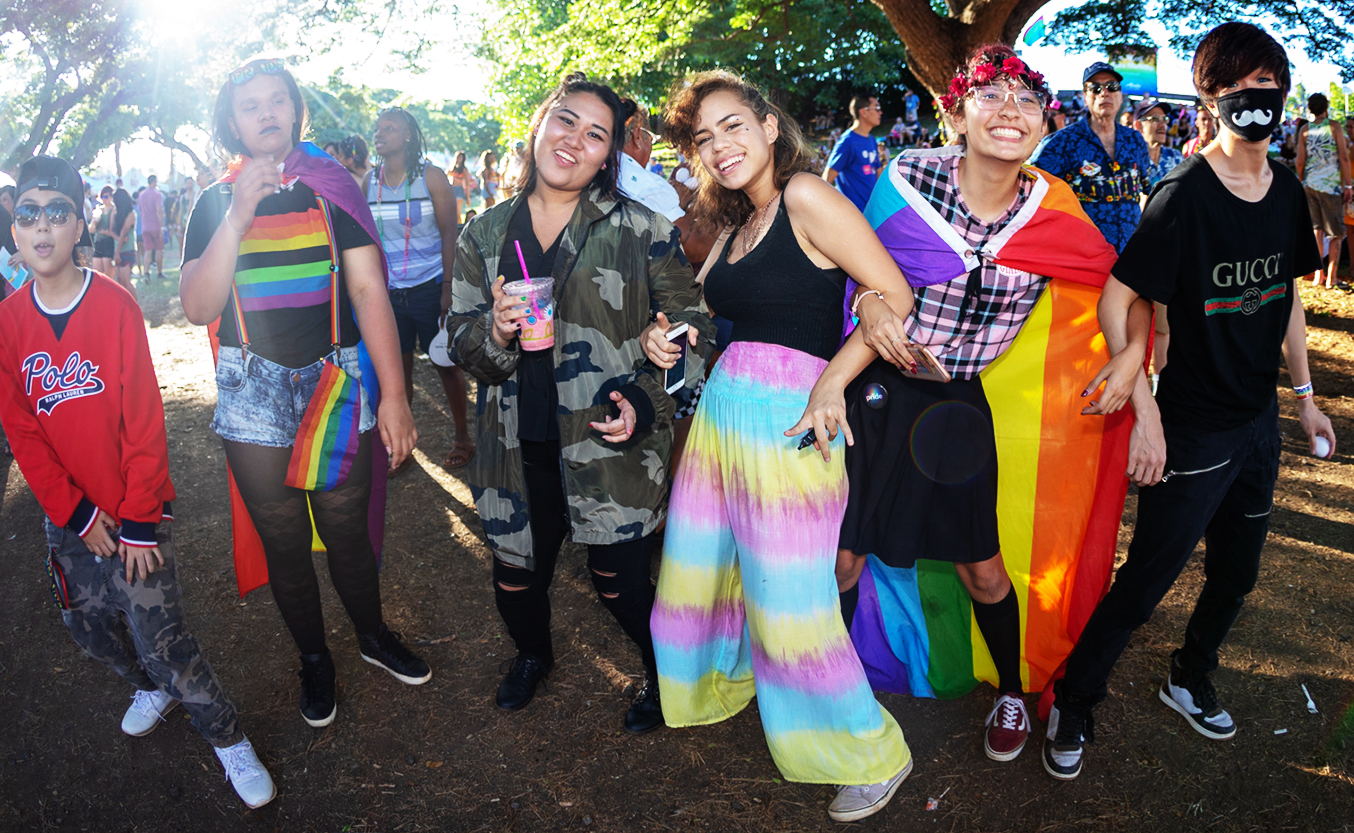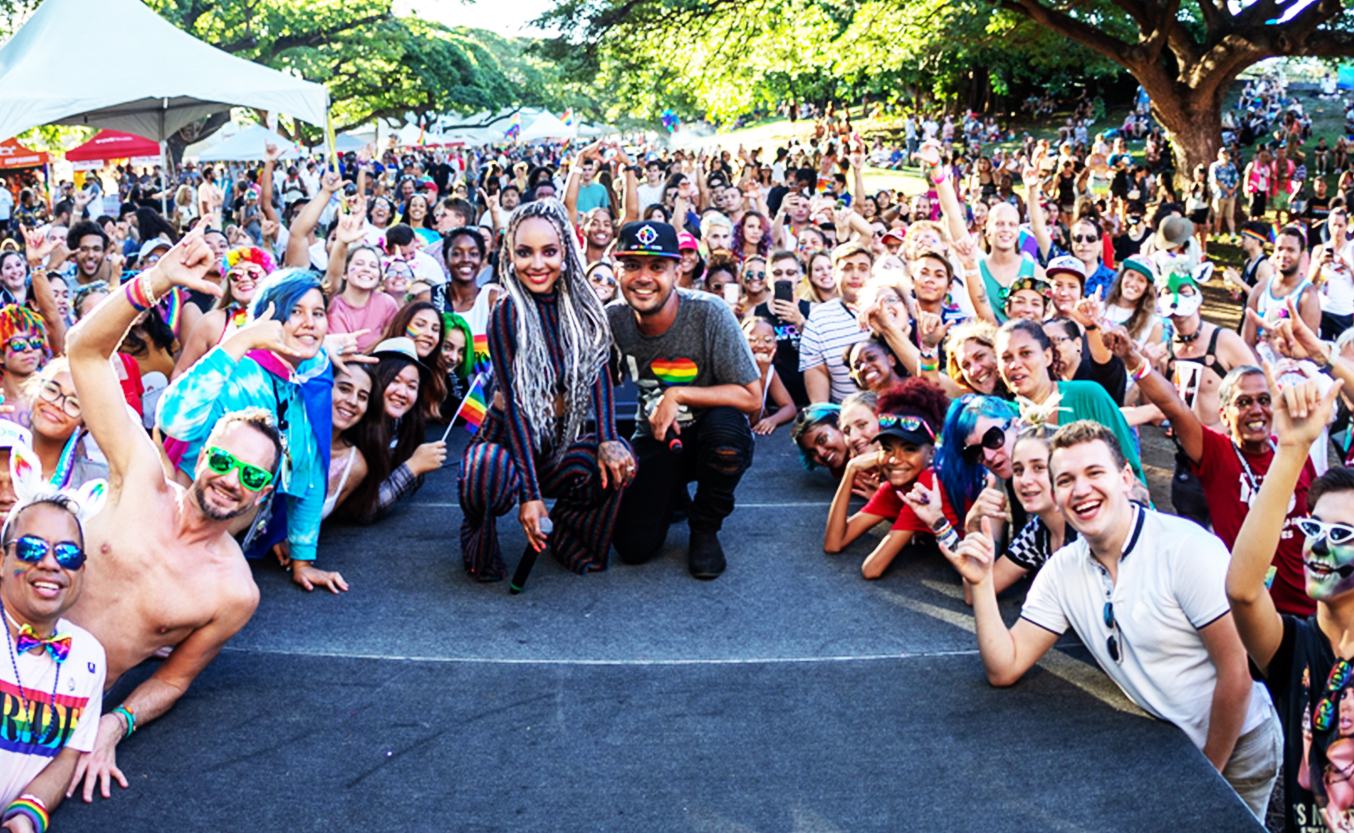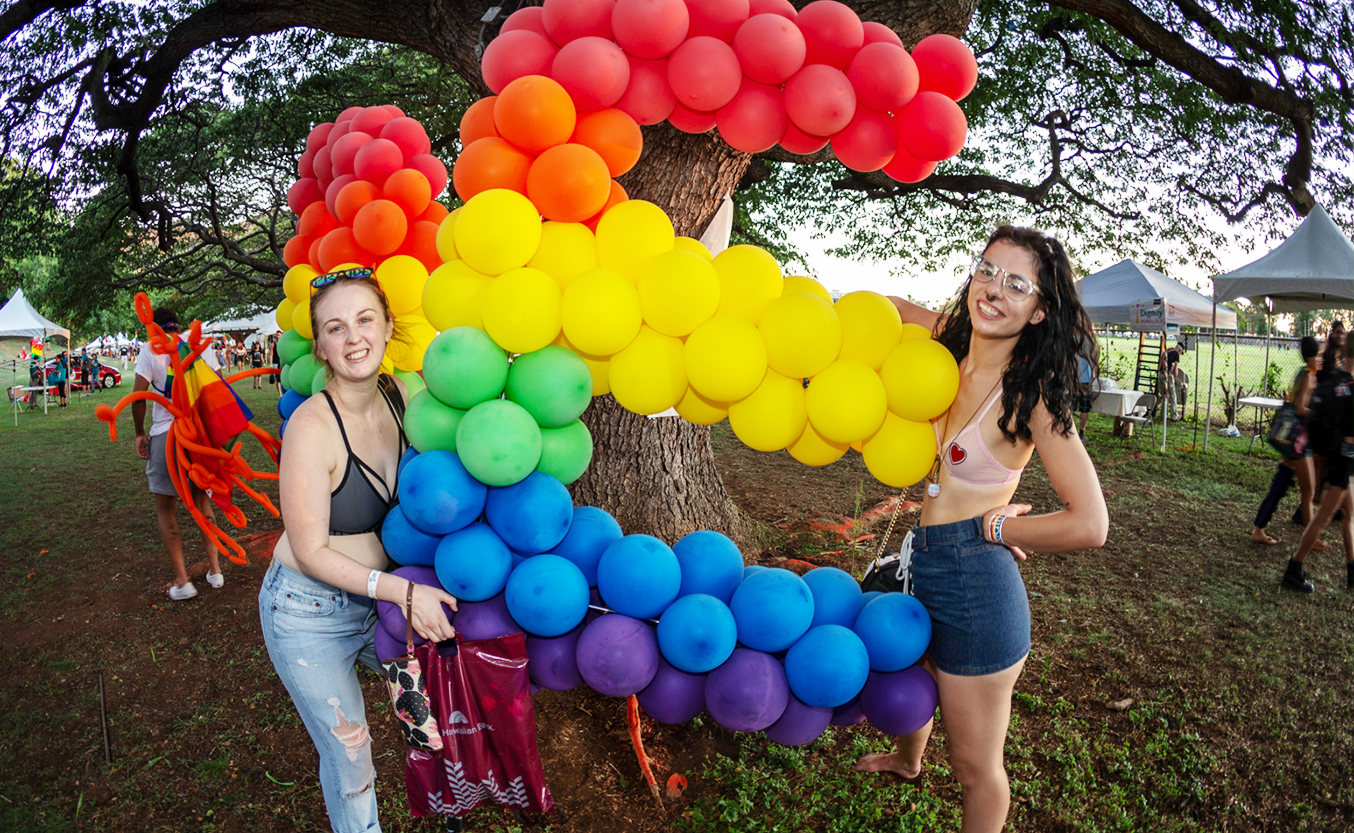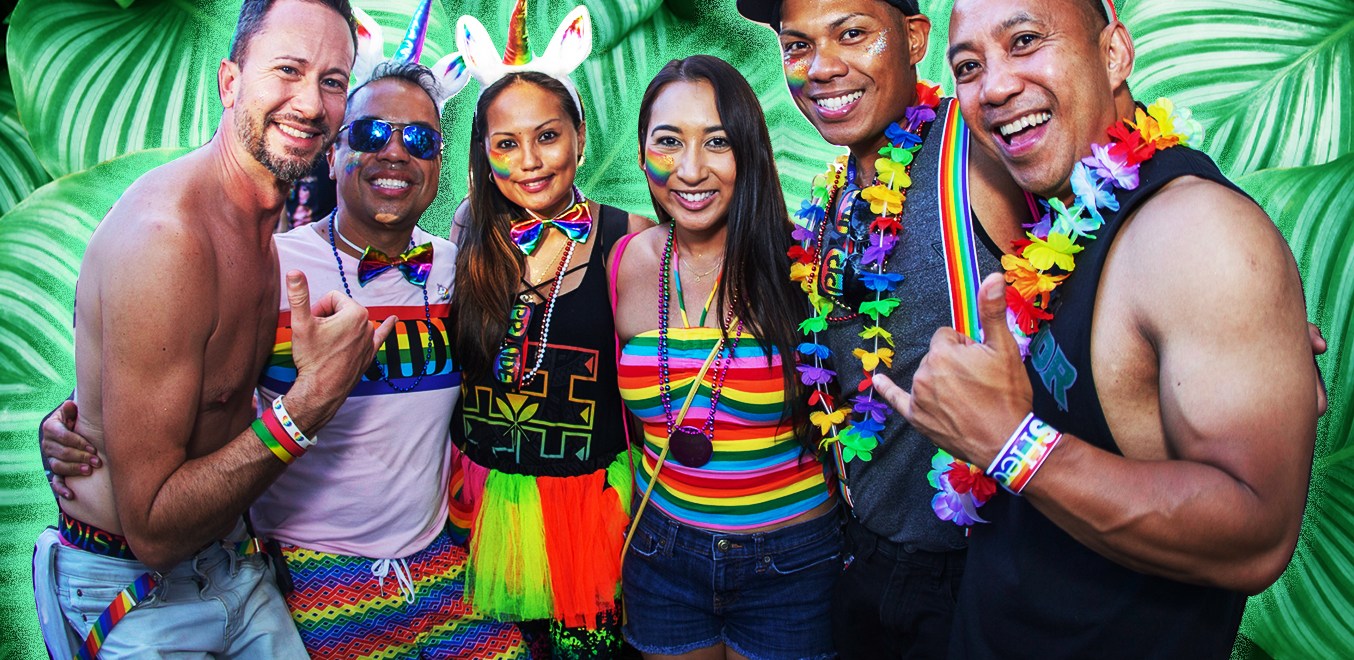I looked out the window of the Four Seasons Oahu at Ko Olina Chapel as the sun began to set over the Pacific. I’d already had a few glasses of wine and been lei’d a few times. The day was winding down. And that’s when I discovered the best bite of food I’ve ever had in my life: coconut sorbet with berries. It was sheer and utter bliss, savored while a pseudo-Jason Mraz played “Here Comes the Sun” on acoustic guitar.
Each bite was full of… well, the flavors are sort of implied — creamy coconut sweetness and fresh, bright berry tartness. “This,” I thought, “is my actual definition of paradise.”
I was elbow-deep in sorbet when the guy sitting next to me asked where I was from. I looked up at his smiling face and very shaved head (which he later told me was an homage to Mr. Clean), and responded, “Los Angeles.” Two words were all I could be bothered to say between bites. Dave was from New York and had been updating the table on the tribulations of his love life. He’d recently broken up with a 24-year-old Italian guy — making his trip to Hawaii for Honolulu Pride, while newly single, feel like timely escapism.
I was also in Oahu for Pride, though not necessarily for the flirting. I was simply eager to experience Pride in someplace other than my home of Los Angeles. If that place happened to be an island paradise where the coconut sorbet flowed freely, so be it.
Earlier in the dinner, I’d learned that the popularity of Honolulu Pride has surged over the past few years, largely thanks to the efforts of its young organizers. I also learned that the Hawaiian Supreme Court was the first state judiciary to declare that making same-sex marriage illegal was inherently unconstitutional, though same-sex marriage wasn’t made legal until 2013. Those elements — plus Hawaii’s particular mix of Indigenous and colonial influences — create a fascinating melting pot that I was just beginning to learn about.
By the end of the meal, I was eager to dive in. Even if I wasn’t feeling as flirt-happy as Dave.

I would only spend until noon the next day at the Four Seasons Oahu before jumping into Pride week, but it was plenty of time to remind me that luxury living is freaking awesome. I started my day with morning yoga down at the cove, which was idyllic — not just because of the setting, but also because it was held at sunrise and I have seldom done exercise at dawn. The three hour time change that West Coasters enjoy when visiting Hawaii was a nice little arrival gift.
After yoga, I savored my last few hours at the resort by going to the “adult pool” to read a memoir that had spent ages in my TBR pile. This no kids allowed oasis featured waiters serving strawberry smoothies and an infinity view. I’m sure I’m not the first person to contemplate remaining childless forever after drinking a 10 am mai tai there.
The rest of my time in Hawaii would be spent in Waikiki and Honolulu Proper, at The Ritz-Carlton Residences (residences that are rented out as hotel rooms). For the uninitiated, Waikiki is like the center of a Venn diagram where island paradise, vibrant nightlife, and youth progressivism converge. For a young traveler seeking relaxation, LGBTQ- friendly partying, and minimal tourists, Waikiki’s Chinatown, specifically, felt like a dream. I started my first night in Waikiki at Tchin Tchin — a low-key bar with an open patio filled with string lights, bespoke cocktails, and just the right level of crowdedness.
Sipping my first cocktail of the night, I made conversation with a New Zealander, also attending Pride. After a few more drinks, I admitted to my new friend that I felt like a bit of an impostor. I was here to cover Pride, a festival that is not made by or for me (I identify as hetero), so I felt a big need to be an ally.
He laughed. “I guess I should really be in my element here, as a gay man at Pride week, but I feel like an imposter too. An imposter in my own community — it’s still such a struggle to feel comfortable being gay. All my friends are straight.”
The night continued at one of Waikiki’s most notorious LGBTQ clubs, Scarlet. I’d been told that Friday nights at Scarlet have a certain legendary mystique and I wasn’t disappointed. I quickly noticed that the bar itself was uniquely representative of the full LGBTQ+ spectrum in the form of life-sized, NSFW Barbie and Ken doll murals, a disco-tiled surfer hanging from the ceiling, and non-binary lesbian mannequins sporting strap-ons. Based on my observations, and listening to my queer-identifying friends, LGBTQ nightlife can often be segregated (i.e. gay men only bars, lesbian nights, and the general erasure of bisexuality and transgender community). But Scarlet seemed to make a point of welcoming literally everyone.
I sat next to the disco light-drenched stage as Beau, an LGBTQ tastemaker in Honolulu, poured me a cranberry-vodka (mostly vodka) cocktail. I asked him if my observation of the crowd rang true for him, and, if so, where the sense of unified community originated from.
“My home in Australia has such a dark history for gay people,” he said, as the club music pulsed and the crowd thickened, “it was illegal for such a long time. But, there’s something unique about Hawaii.”
As he shared his personal experience, Beau also shared the inherent fluidity of Polynesian culture.
“Say a Polynesian family has seven boys,” he continued. “The youngest will be raised to support the household, help with the wash and cooking and such. It doesn’t matter that they’re boys. There’s a lack of conforming to traditional gender roles in Polynesian culture, so there’s a bit of a basis already built in that is accepting of people who are different.”
The lack of rigid gender roles in Polynesian culture, according to Beau, also birthed a word for a third gender, mahu, which means “embodiment of two spirits.” This was a fitting segue into Scarlet’s drag show, notorious throughout the community. Beau and I turned our attention to the lip-syncing queens in outrageous femme costumes strutting down the runway while being showered with dollar bills.
It was, epic and gaudy and wonderful — the best drag show I’ve ever seen.

I woke up in a haze on the morning of the Honolulu Pride parade after a few too many cocktails. I’m not really much of a cocktail drinker but Hawaiian fruit juices are a heavenly mask for hard liquor. The Pride float I was slated to ride on (I had no idea I would be in the parade when I touched down, but who says “no” to that?) came courtesy of Lei Culture Magazine, a young publication for LGBTQ travelers. My travel crew, along with the Lei Culture staff and a few locals rode together, waving extra-large palm leaves and sipping some kind of delicious alcoholic elixir flavored with guava. The sound system on the float blasted a hit parade that spanned from Nicki Minaj to ABBA (obviously), as we cruised the beach-lined streets of Honolulu.
Beaming back at us, singing and dancing along with the music, we saw everyone from trans-women flashing their elaborate costumes and dance moves like elegant peacocks, nuclear families with t-shirts proclaiming “ALLY AF”, and locals in stunning leis and Hawaiian traditional dress. Hundreds, maybe thousands, of locals and tourists alike cheered and waved rainbow flags. I leaned over to Jordan, a woman who worked at the cool-kid beloved Surfjack Hotel, and asked how long Pride had been this big on Oahu.
“No, I’ve never seen a turn out like this,” she smiled, blowing bubble streams into the crowd. “I grew up in Maui and no one ever really noticed Pride. It wasn’t something anyone really showed up for. I left for the mainland for about five years, and when I came back it was like everything changed. People see us now. It’s a celebration.”
The streets grew thicker with crowds as we entered downtown, decked with rainbows and signs declaring, “Aloha is Aloha” — perhaps the best ally-line I’ve ever heard. My float crew danced and sang, fully in the moment and basking in the delight of such a remarkable turnout. I cannot know what this day truly meant to the natives of Oahu, or to my queer-identifying friends on the trip, but the spirit of the festival and the vibrancy of the crowds and fellow floats was truly something to witness.

Wanting to do the tourist thing without Waikiki-beach levels of tourists, I spent the next morning visiting the ‘Iolani Palace. Other than the fact that the building itself has an old European colonial architecture vibe, the politics and history of Hawaii’s royal family struck me as being quite different from their European counterparts in all the right ways. Queen Kapiolani (who reigned from 1894-1891), in particular, stood out as basically a feminist badass who created a women’s hospital that’s still in use today. The general politics of her regime were largely based on the needs of the people and the land — including fostering a 90% literacy rate for the Hawaiian population.
Later, as Hawaii grew increasingly more colonized by the United States, many natives were converted to Christianity (the more rural regions of the islands still preserve a conservative mindset). As Hawaii became an idyllic vacation destination for Asia, Australia, and nuclear American families, the efforts to preserve Hawaiian progressivism struggled. Hawaiian rep Tulsi Gabbard has a historically fraught relationship with LGBTQ+ acceptance herself, though she’s now decidedly an ally. Through the resurgence of traditional Polynesian culture and the efforts of younger queer residents who have taken over the organization of Oahu Pride, Oahu seems to have returned to progressivism. I left ‘Iolani Palace thinking that Queen Kapiolani would be proud of the direction things are headed.
That afternoon, I boarded a sunset cruise courtesy of Hawaii Nautical. On my final night in Oahu, I laid out over the bow as the boat pulled farther away from the harbor. The Honolulu coast was lined with luxury high rises set against a glorious mountain backdrop. I watched as my crew continued to drink and laugh, glowing from what felt like a week-long spa day. The prospect of returning home to work emails and bills remained inconsequential as the catamaran gently bounced over the waves, the sky melting from brilliant blue to soft pink. I’d gained a sort of kinship with my fellow Pride attendees that I couldn’t really put my finger on – maybe it was the overt declaration of humanity, the stillness of the island, or something else as tough-to-define-yet-remarkable. As the sun began to fade across the horizon, I thought back to my night at Scarlet, and of Beau as he told me about Pride. He looked at me with such giddy joy as he confessed his love for Oahu.
“Sometimes,” he beamed, “I go to the beach alone and just massage the sand, and take in the earth. It’s just something I feel, inherent to the energy of the island, that I never got back home. I feel the grains of sand run through my fingers, and I know I have ‘ohana [family]. For me, the spirit of everyone, and everything here is Pride.”
Honolulu Pride 2019 will be held on Saturday, October 19th.
Uproxx was hosted for this story by Oahu Visitors Bureau. However, they did not review or approve this story. You can learn more about the Uproxx Press Trip policy here.







